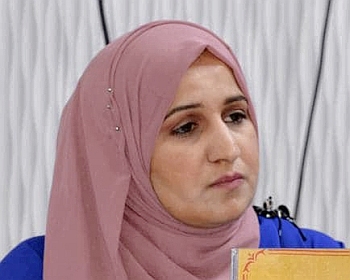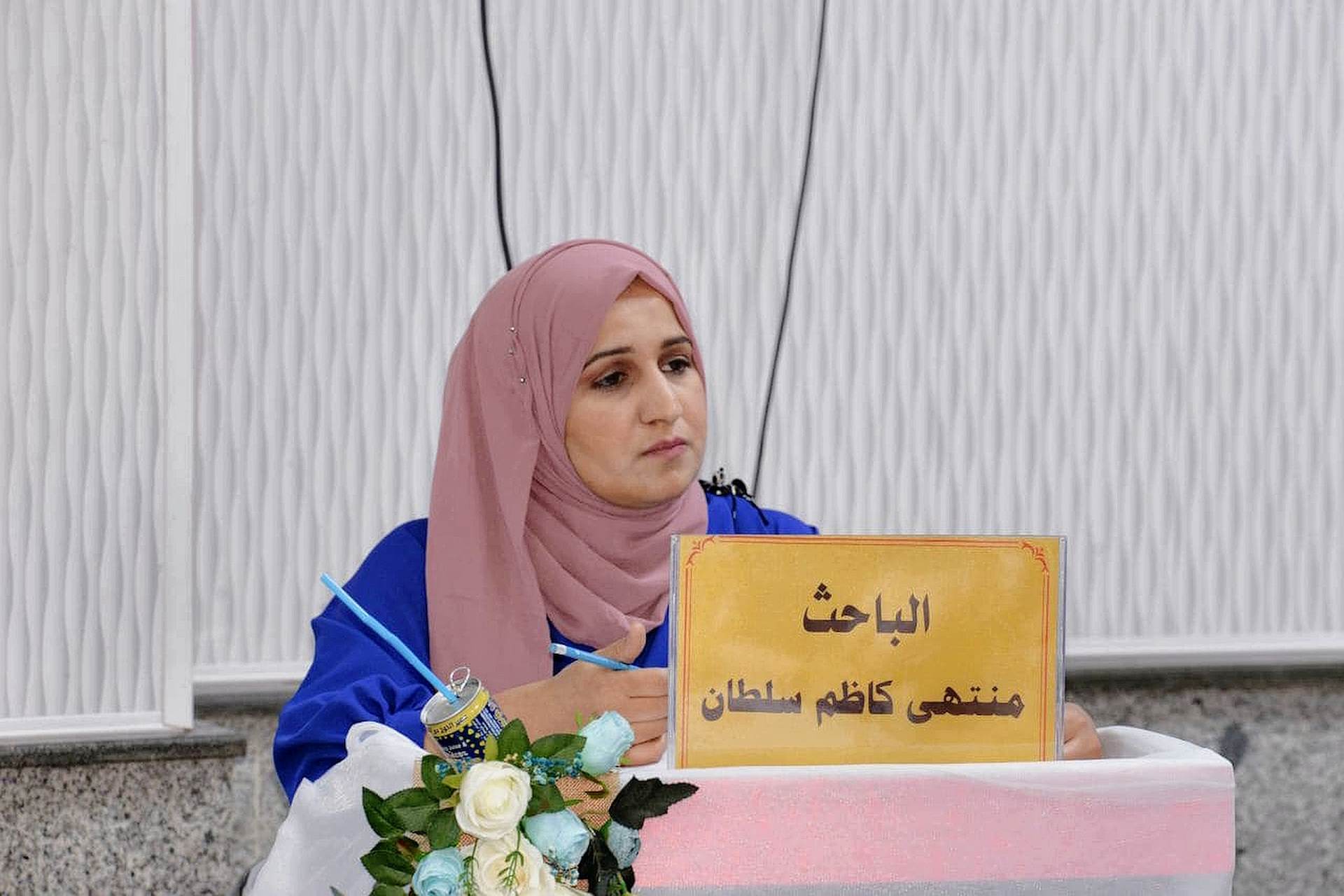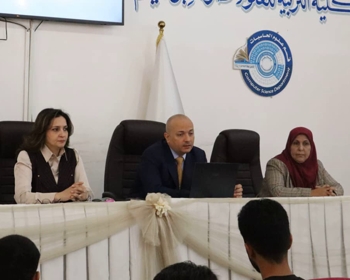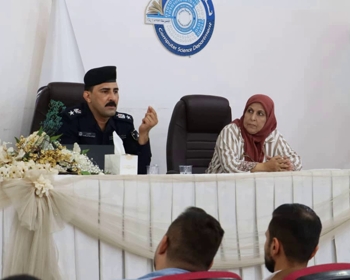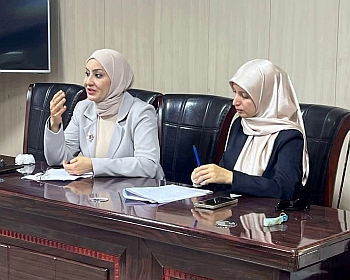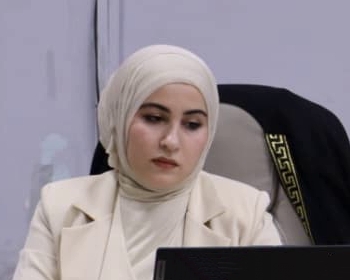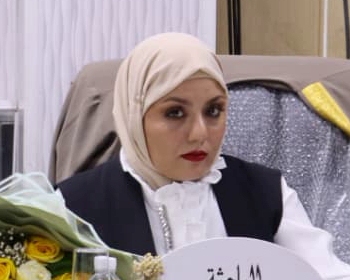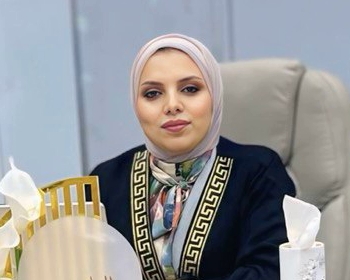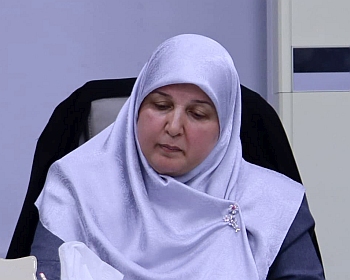ناقش قسم الكيمياء في كلية التربية للعلوم الصرفة (ابن الهيثم) رسالة الماجستير الموسومة ” دراسة ثرموديناميكية وحركية لامتزاز صبغة المثيل البرتقالي من محاليلها المائية على سطوح اطيان عراقية مختارة ” للطالبة ” منتهى كاظم سلطان سلمان ” التي انجزتها باشراف التدريسية في القسم ” أ . م .د. سهاد شاكر محمد ” . ونوقشت من قبل اعضاء لجنة المناقشة المبينة اسمائهم في ما يأتي :
-
أ.د. انتصار عليوي لعيبي – رئيسا
-
أ.م.د. لقاء حسين علوان – عضوا
-
أ.م.د. رواء حسين علي – عضوا
-
أ.م.د. سهاد شاكر محمد عضوا ومشرفا
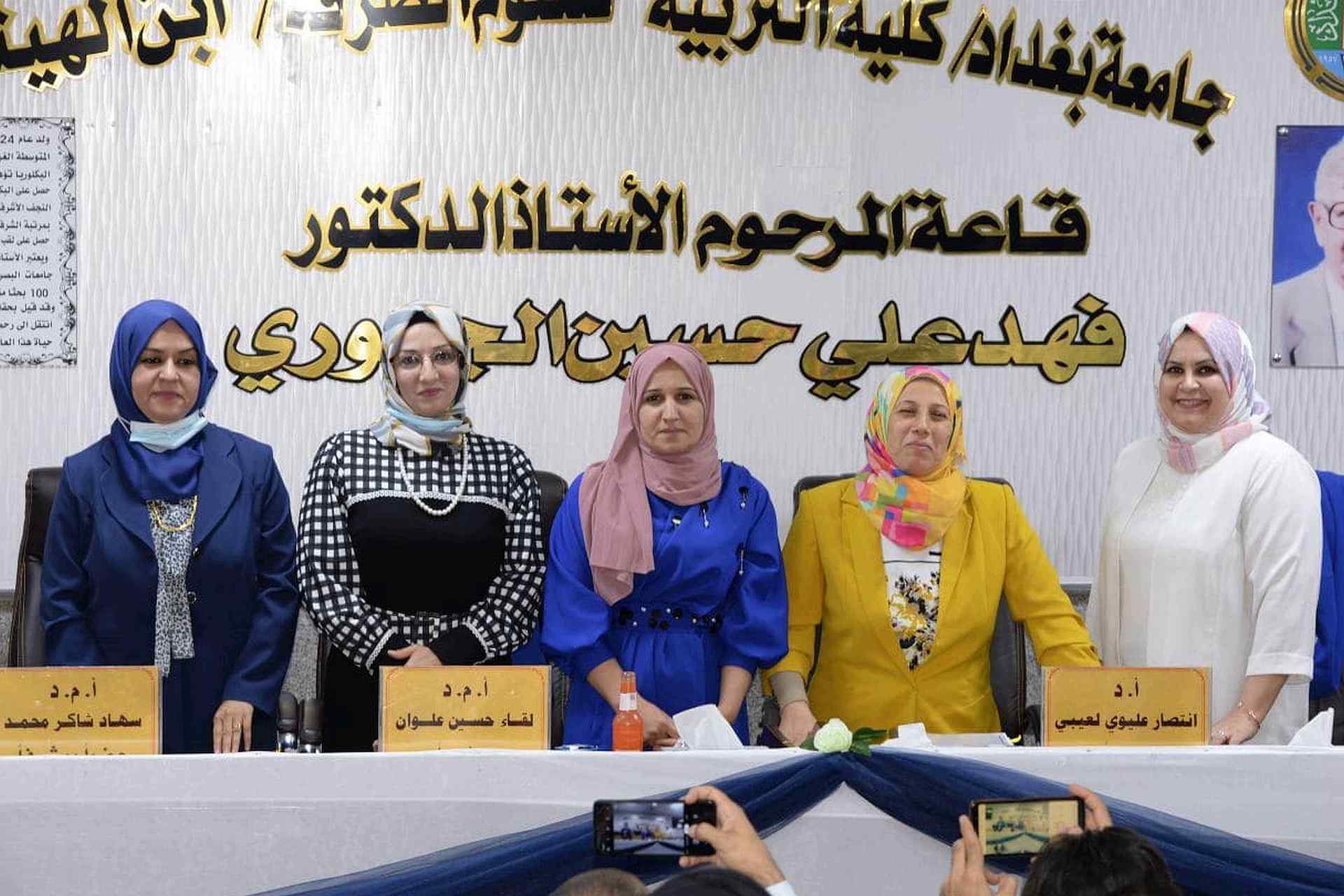 وتهدف هذه الدراسة الى :
وتهدف هذه الدراسة الى :
-
ازالة احد انواع الاصباغ السامة السالبة وهي صبغة المـثيل البرتقالي ( MO) مـن محاليلها المائية باستـعمال اطيان عـراقية مختارة وهـي ( البنتونايت والفلنت ) كسـطوح مازة لازالة الـملوثات ومعـالجة المياه المـلوثة من هذه الصبغة السامة
-
تهدف الدراسة الى تشخيص هذه السطوح باستخدام تقنية ( AFM) .
-
دراسة حركية امتزاز الصبغة من خلال تطبيق اكثر من نموذج حركي على هذه السطوح وكذلك حساب الثوابت الحركية لهذه النماذج .
-
تهدف الدراسة الى ايجاد الظروف المثلى والمناسبة للامتزاز والتي تتضمن ( وزن السطح الماز ، درجة الحرارة ، تركيز المادة الممتزة ، الشدة الايونية والـدالة الحامضية ) .
-
ايجاد ايزوثيرمات ومعادلات الامتزاز الملائمة لامتزاز صبغة المثيل البرتقالي على السطوح المازة من خلال تطبيق اكثر من نموذج ايزوثيرمي وعمل مقارنة بينهما.
-
حساب الدوال الثرموديناميكية لعملية امتزاز الصبغة على السطوح قيد الدراسة .
-
استخدام نموذجين من دوال الخطأ وهما SSE,EAS لمعرفة افضل نموذج ايزوثيرم تم استخدامه .
تنـاولت هـذه الـدراسة سـطح البنتونايت ( B ) وسطح الفلنت ( F ) المتوفر محـليا فـي الـعراق ودراسة امتزاز صبغة المثيل البرتقالي (Methyl Orang ) على السطوح المذكورة اعلاه من اجل الوصول الى معرفة فعالية هذه الأسطح وامكانية استعمالها كسطوح مازة لمعالجة تلوث المياه الذي يحصل سبب استعمال هذه الصبغة . وايضا استعمال مطيافيه الاشعة المرئية –فوق البنفسجية من اجل تعين كمية الامتزاز ، معرفة حركيات و ايزوثيرمات الامتزاز في ظروف مختلفة مـن زمـن الاتزان ، درجـات حـرارة مخـتلفة ، دالـة حامـضية ، شـدة ايونية ، ووزن السطـح الـمـاز. وقد بينت النتائج :ـ
1- تطبيق نماذج حركيات المرتبة الاولى الكاذبة ، المرتبة الثانية الكاذبة ، نموذج الوفيج ونموذج الانتشار الجزيئي الضمني ومن خلال الاعتماد على القيم العملية والنظرية لكميات الامتزاز وقيم معامل الارتباط ( R2) وقيم ثوابت السرعة تبين انطباق الموديل الحركي للمرتبة الثانية الكاذبة على عملية امتزاز صبغة المثيل البرتقالي من محلولها المائي على السطحين قيد الدراسة .
2- تعين طاقة التنشيط لعملية الامتزاز على السطحين مـن خـلال الاعتمـاد علـى ثوابت النموذج الـحركـي للمرتبة الثانية الكاذبة اذ كانت طاقة التنشيط للسطـح الاول B ( 75.84 kJ\mole ) وللسطـح الثاني F ( 14.74 kJ\mole ) .
3- دراسة عملية الامتزاز عند درجات حرارية مختلفة K( 303,313,323 ) واظهرت النتائج ان كمية امتزاز صبغة المثيل البرتقالي على سطح الـ B تزداد بزيادة درجات الحرارة ( العملية ماصة للحرارة ) بينما سطـح الـ F حصل العـكـس اذا قلـت كـمية الـمادة الممتزة مع زيادة درجات الحرارة ( العملية باعثة للحرارة ) .
4- تطبيق نماذج مختلفة من ايزوثيرمات الامتزاز (Temkin , Freundlich , Langmuir ) وبينت النتائج عدم تطابقها مع ايزوثيرم لانكماير لجميع الانظمة وانطباقها مع ايزوثيرم تمكن وبصورة اقل مع ايزوثيرم فرندلش .
5- حسـاب الـدوال الثرموديناميكية لأنظمة الامــتزاز وبينت النتائج قيمـة الانثالبي (∆H=+12.9033 kJ) موجبة وهذا يدل على ان التفاعل ماص للحرارة للسطح الاول B وكانت قيمة (2.0529 kJ- =H∆) سالبة اي ان التفاعل باعث للحرارة للسطح الثاني F ، كما وبينت النتائج القيمة الموجبة للانتروبي (+52.2426 , +3.9865 J\mol.K ◦S∆ ) على الزيادة العشوائية للسطحين قيد الدراسة ، اما طاقة كبس ( G◦∆ ) فكانت سالبة للسطحين وعند درجات حرارية مختلفة وهذا يبين الى تلقائية عملية الامتزاز .
6- مع زيادة الدالة الحامضية (pH ) تقـل كمية سـعة الامتزاز للسطحين .
7- مع زيادة تركيز الملح تقـل سعة الامتزاز بالنسبة للسطح الاول على عكس السطح الثاني .
8- حساب قيم معمل الارتباط ( R2 ) وتحـليـل نسبة الخطأ باستخدام نموذجين ( EAS , SSE ) لغرض معرفة افضل نموذج ايزوثيرم تم استخدامه في هذه الدراسة حيث كانت نتائج نموذج (SSE) هي ملائمة اكثر .
وخلصت الطالبة الى التوصيات الاتية:
اولت هذه الدراسة معالجة المياه الملوثة بصبغة من الاصباغ الحامضية وباستعمال سطوح البنتونايت و الفلنت كمواد مـازة
لـذلك نـوصي ببعض النقاط لـغـرض تنفيذها مـن الباحثين فيـما بعد :
1- دراسة أخرى تتضمن امتزاز العناصر الثقيلة او اصباغ اخرى على السطوح المستعملة في هذه الدراسة نفسها.
2- اجراء التعديل بمواد نانوية على سطح طين البنتونايت والفلنت وبااستعمال مواد فعالة سطحيا.
3- اجراء التعديل باستعمال مواد ذات فعالية سطحية .
4- استعمال موديلات اخرى من النماذج الحركية وموديلات امتزاز اخرى غير مذكورة في الدراسة .
Thermodynamic and Kinetic Study of Adsorption of Methyl Orange dye from their Aqueous Solutions on Selected Iraqi Clays Surfaces
By Muntaha Kadhum Sultan
Supervised by Asst.prof.Dr.Suhad shakir
Aim of the study
– The aim of this study is to remove one of the negative toxic dyes, methyl orange (MO), from their aqueous solutions by using selected Iraqi clays (bentonite and flint) as absorbent surfaces to remove pollutants and treat polluted water from this toxic dye
– The study aims to diagnose these surfaces using (AFM) technique
– Studying the kinetics of dye adsorption by applying more than one kinetic model to these surfaces, as well as calculating the kinetic constants of these models
– The study aims to find the optimal and suitable conditions for adsorption, which include (adsorbing surface weight, temperature, adsorbent concentration, ionic strength and acidity function)
– Finding the appropriate isotherms and adsorption equations for adsorption of methyl orange dye on adsorbent surfaces by applying more than one isotherm model and comparing them
– Calculating the thermodynamic functions of the dye adsorption process on the surfaces under study
– Using two models of error functions, namely SSE and EAS, to find out the best isotherm model that was used
Abstract
In this study, I looked at the surface of the Bentonite (B) and the surface of the flint (F) available locally in Iraq and dealt with the adsorption of the methyl Orang on the surfaces in order to find out the effectiveness of these surfaces and the possibility of using them as a surface to treat water pollution that occurs as a cause of the use of this dye. Visible-UV spectrometers were used to determine the amount of adsorption, to know the movements of adsorption Isothermats in different conditions of balance time, different temperatures, acid function, ionic intensity, and the weight of the surface of the mas. The results showed
-
The first and second kinetic order models, elovichand implicit molecular diffusion were applied to the experimental data and depended on the experimental and theoretical values of the adsorption quantities and the correlation coefficient values R2 with the rate constants , the second kinetic order model was fitted to the process of adsorption of methyl Orang dye from Aqueous solution by all the surfaces under study
-
The activation energy of the adsorption process on the surfaces was assigned by relying on the parameters of the second –order kinetic model place as the activation energy of the first surface B (75.84 KJ\mole) and the second surface F (14.74 KJ \ mole)
-
The process of adsorption at different temperatures (303,313,323) K the results showed that the methyl orange adsorption on the surface B increases by increasing temperatures (endothermic process) while the surface of the F occurs the opposite if the amount of the material is reduced with increased temperatures (exothermic process)
-
Different models of adsorption isotherme ( Temkin , Freundlich, Langmuir) have been applied and the results have shown that they do not match with Isotherm Langmuir for all systems and their application with Isotherm Temkin and less with Isotherm Freundlich
-
Thermodynamic functions of adsorption systems were calculated and Enthalpy (∆H) positive and this indicates that the interaction endothermic process B , and the value (∆H) was negative the interaction exothermic process is The second F, as the results showed the positive value of the entropy (∆S) on the random increase of the two surfaces under study, while the value of Gibbs free energy (∆G) was negative for the surfaces and at different temperatures and this shows the spontaneous of the adsorption process
-
With the increase of the acid function (pH) the amount of adsorption capacity of the two surfaces decreases
-
With increased salt concentration, the capacity of the B surface is decreased , unlike the second surface
-
The values of the correlation coefficient (R2) were calculated and the error rate was analyzed using two models (EAS,SSE) for the purpose of knowing the best isotherm model used in this study

